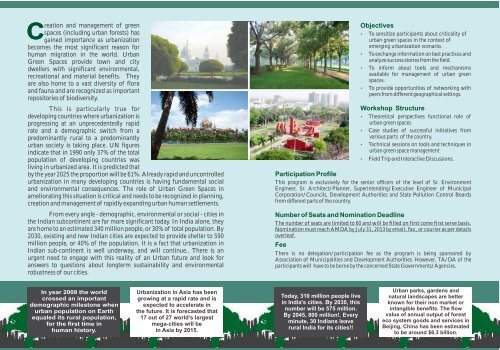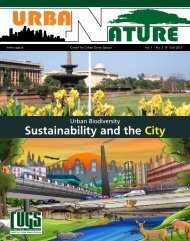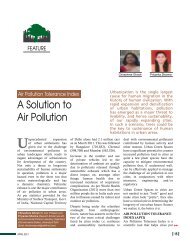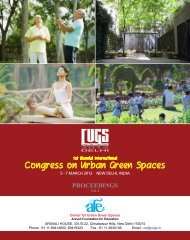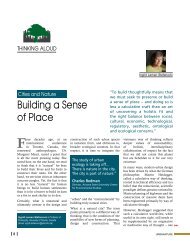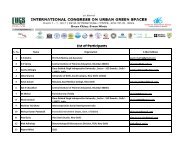26-27 August 2013 - Center for Urban Green Spaces
26-27 August 2013 - Center for Urban Green Spaces
26-27 August 2013 - Center for Urban Green Spaces
Create successful ePaper yourself
Turn your PDF publications into a flip-book with our unique Google optimized e-Paper software.
C<br />
reation and management of green<br />
spaces (including urban <strong>for</strong>ests) has<br />
gained importance as urbanization<br />
becomes the most significant reason <strong>for</strong><br />
human migration in the world. <strong>Urban</strong><br />
<strong>Green</strong> <strong>Spaces</strong> provide town and city<br />
dwellers with significant environmental,<br />
recreational and material benefits. They<br />
are also home to a vast diversity of flora<br />
and fauna and are recognized as important<br />
repositories of biodiversity.<br />
This is particularly true <strong>for</strong><br />
developing countries where urbanization is<br />
progressing at an unprecedentedly rapid<br />
rate and a demographic switch from a<br />
predominantly rural to a predominantly<br />
urban society is taking place. UN figures<br />
indicate that in 1990 only 37% of the total<br />
population of developing countries was<br />
living in urbanized area. It is predicted that<br />
by the year 2025 the proportion will be 61%. Already rapid and uncontrolled<br />
urbanization in many developing countries is having fundamental social<br />
and environmental consequences. The role of <strong>Urban</strong> <strong>Green</strong> <strong>Spaces</strong> in<br />
ameliorating this situation is critical and needs to be recognized in planning,<br />
creation and management of rapidly expanding urban human settlements.<br />
From every angle - demographic, environmental or social - cities in<br />
the Indian subcontinent are far more significant today. In India alone, they<br />
are home to an estimated 340 million people, or 30% of total population. By<br />
2030, existing and new Indian cities are expected to provide shelter to 590<br />
million people, or 40% of the population. It is a fact that urbanization in<br />
Indian sub-continent is well underway, and will continue.. There is an<br />
urgent need to engage with this reality of an <strong>Urban</strong> future and look <strong>for</strong><br />
answers to questions about longterm sustainability and environmental<br />
robustness of our cities.<br />
Objectives<br />
Ÿ To sensitize participants about criticality of<br />
urban green spaces in the context of<br />
emerging urbanization scenario.<br />
Ÿ To exchange in<strong>for</strong>mation on best practices and<br />
analyze success stories from the field.<br />
Ÿ To in<strong>for</strong>m about tools and mechanisms<br />
available <strong>for</strong> management of urban green<br />
spaces.<br />
Ÿ To provide opportunities of networking with<br />
peers from different geographical settings.<br />
Workshop Structure<br />
Ÿ Theoretical perspectives functional role of<br />
urban green spaces<br />
Ÿ Case studies of successful initiatives from<br />
various parts of the country.<br />
Ÿ Technical sessions on tools and techniques in<br />
urban green space management<br />
Participation Profile<br />
This program is exclusively <strong>for</strong> the senior officers of the level of Sr. Environment<br />
Engineer, Sr. Architect/Planner, Superintending/Executive Engineer of Municipal<br />
Corporation/Councils, Development Authorities and State Pollution Control Boards<br />
from different parts of the country.<br />
Number of Seats and Nomination Deadline<br />
The number of seats are limited to 60 and will be filled on first come first serve basis.<br />
Nomination must reach AMDA by July 31, <strong>2013</strong> by email, fax, or courier as per details<br />
overleaf.<br />
Fee<br />
Ÿ<br />
Field Trip and Interactive Discussions.<br />
There is no delegation/participation fee as the program is being sponsored by<br />
Association of Municipalities and Development Authorities. However, TA/DA of the<br />
participants will have to be borne by the concerned State Governments/Agencies.<br />
In year 2008 the world<br />
crossed an important<br />
demographic milestone when<br />
urban population on Earth<br />
equaled its rural population,<br />
<strong>for</strong> the first time in<br />
human history.<br />
<strong>Urban</strong>ization in Asia has been<br />
growing at a rapid rate and is<br />
expected to accelerate in<br />
the future. It is <strong>for</strong>ecasted that<br />
17 out of <strong>27</strong> world's largest<br />
mega-cities will be<br />
in Asia by 2015.<br />
Today, 310 million people live<br />
in India's cities. By 2030, this<br />
number will be 575 million.<br />
By 2045, 800 million!. Every<br />
minute, 30 Indians leave<br />
rural India <strong>for</strong> its cities!!<br />
<strong>Urban</strong> parks, gardens and<br />
natural landscapes are better<br />
known <strong>for</strong> their non market or<br />
intangible benefits. The flow<br />
value of annual output of <strong>for</strong>est<br />
eco system goods and services in<br />
Beijing, China has been estimated<br />
to be around $6.3 billion.


